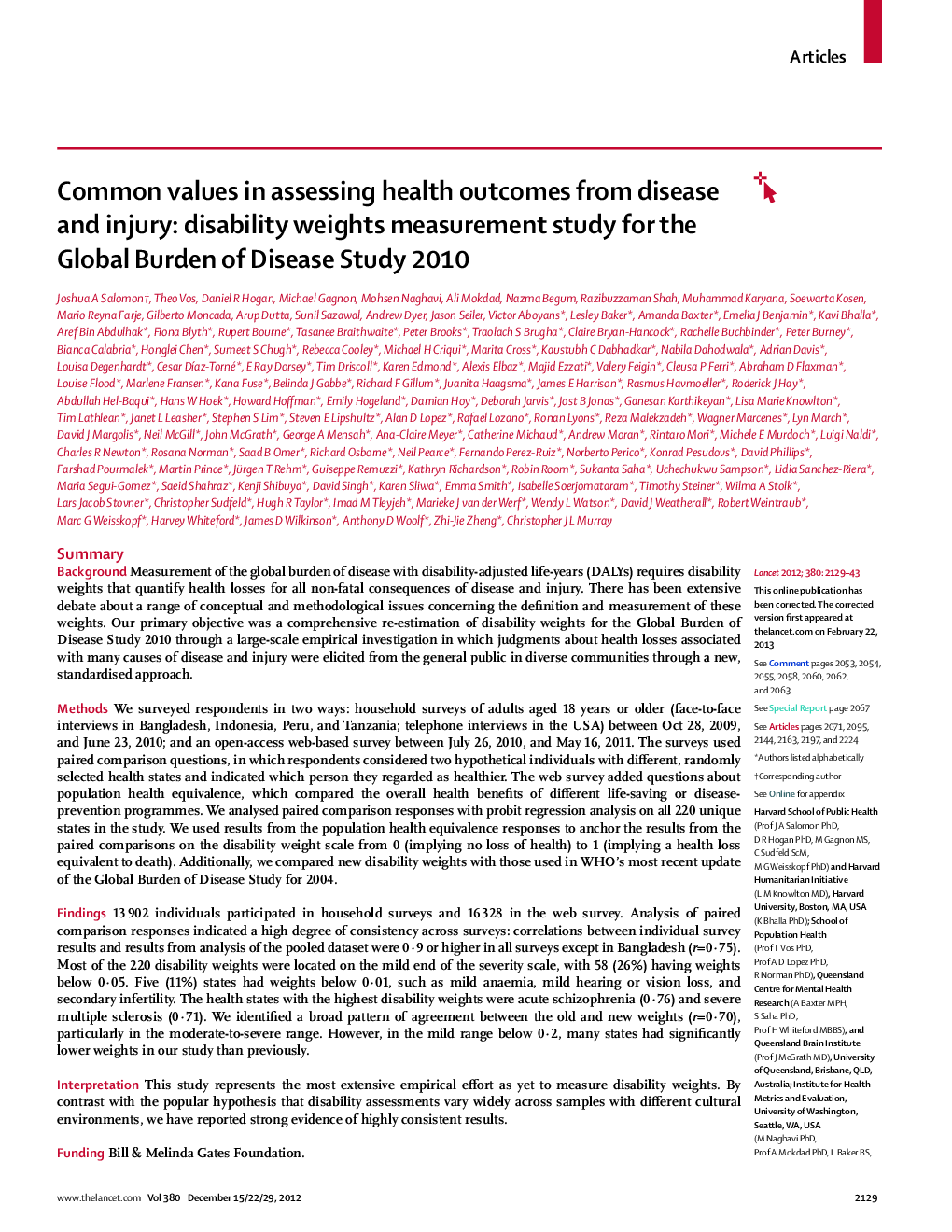| کد مقاله | کد نشریه | سال انتشار | مقاله انگلیسی | نسخه تمام متن |
|---|---|---|---|---|
| 3491269 | 1597142 | 2013 | 15 صفحه PDF | دانلود رایگان |

SummaryBackgroundMeasurement of the global burden of disease with disability-adjusted life-years (DALYs) requires disability weights that quantify health losses for all non-fatal consequences of disease and injury. There has been extensive debate about a range of conceptual and methodological issues concerning the definition and measurement of these weights. Our primary objective was a comprehensive re-estimation of disability weights for the Global Burden of Disease Study 2010 through a large-scale empirical investigation in which judgments about health losses associated with many causes of disease and injury were elicited from the general public in diverse communities through a new, standardised approach.MethodsWe surveyed respondents in two ways: household surveys of adults aged 18 years or older (face-to-face interviews in Bangladesh, Indonesia, Peru, and Tanzania; telephone interviews in the USA) between Oct 28, 2009, and June 23, 2010; and an open-access web-based survey between July 26, 2010, and May 16, 2011. The surveys used paired comparison questions, in which respondents considered two hypothetical individuals with different, randomly selected health states and indicated which person they regarded as healthier. The web survey added questions about population health equivalence, which compared the overall health benefits of different life-saving or disease-prevention programmes. We analysed paired comparison responses with probit regression analysis on all 220 unique states in the study. We used results from the population health equivalence responses to anchor the results from the paired comparisons on the disability weight scale from 0 (implying no loss of health) to 1 (implying a health loss equivalent to death). Additionally, we compared new disability weights with those used in WHO's most recent update of the Global Burden of Disease Study for 2004.Findings13 902 individuals participated in household surveys and 16 328 in the web survey. Analysis of paired comparison responses indicated a high degree of consistency across surveys: correlations between individual survey results and results from analysis of the pooled dataset were 0·9 or higher in all surveys except in Bangladesh (r=0·75). Most of the 220 disability weights were located on the mild end of the severity scale, with 58 (26%) having weights below 0·05. Five (11%) states had weights below 0·01, such as mild anaemia, mild hearing or vision loss, and secondary infertility. The health states with the highest disability weights were acute schizophrenia (0·76) and severe multiple sclerosis (0·71). We identified a broad pattern of agreement between the old and new weights (r=0·70), particularly in the moderate-to-severe range. However, in the mild range below 0·2, many states had significantly lower weights in our study than previously.InterpretationThis study represents the most extensive empirical effort as yet to measure disability weights. By contrast with the popular hypothesis that disability assessments vary widely across samples with different cultural environments, we have reported strong evidence of highly consistent results.FundingBill & Melinda Gates Foundation.
Journal: - Volume 380, Issue 9859, 15 December 2012–4 January 2013, Pages 2129–2143